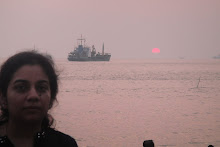
Title : The Age of Kali
Author : William Dalrymple
Publisher : Penguin India
ISBN : 978-0-143-03109-3
Kaliyug or the Period of Kali is the last of the four Hindu periods contained in mahayuga - the great age of the world. The age of Kali is when the imperfections are so overpowering that the doomsday is not far behind and a new cycle begins.
After having read 'The Age of Kali' by William Dalrymple, I just wondered, perhaps defining India means, getting the feeling of 'Neti Neti' (its neither this, nor that). Such unbelievable diversity in every aspect of human existence - from religion, culture, dressing habits, eating habits, faiths, beliefs, notions, values, to of course financial levels. As is said about Mahabharata, if it is not in this big epic, it is nowhere in the world. I think the same can be said about India to a certain extent.
William Dalrymple brings to us the glimpses of such huge multifariousness in the Indian subcontinent through the essays which chronicle a nation's struggle to rise above the ancient and modern forces which are trying to pull it in opposite directions.
He has brought out the coexistence of stark contrast by introducing the readers to the land of kamasutra, the land where shivalinga is one of the most sacred symbols in the temples, the land celebrating the beauty in the form of Khajuraho figurines and the same land where 'Sati mata' is still revered in some parts, where a woman (Sathin) is severely penalized for having attempted to stop a child marriage and where widows are left to begging in the streets of Vrindavan. But this is not all. He also opens a small window to peek inside the glitterati of Bollywood - the film industry of India and where women like Shobha De cater to the needs of people looking for spicy gossips and erotic writings.
Then there are some essays on the places like Lucknow, which bloomed culturally under the reigns of Mughal emperors and Nawabs who were 'liberal and civilized figures' - the great connoisseurs of poetry, dances, books and plethora of art forms. But such places are now completely bankrupt after having endured the plunder by Britishers, and by corrupt politicians, government officials and drug tycoons, post independence. In states like Bihar and Uttar Pradesh anarchy is rampant, especially in political arenas where elections are won by power, money and force rather than fair play. On the other hand there is Bangalore which has been unofficially christened as 'Silicon Valley of India' and offers hope of a better tomorrow for the whole country.
The author then talks about the financial and economic revolution by reporting about how the middle class families struggled in the seventies to buy their first fridge or a black and white television but quite suddenly there seemed to be a lot of money post 1989 economic deregulations and free market reforms. And subsequent deluge of TV channels brought the cultural invasion in the country.
There are some observations that he has very rightly made - India is struggling to shake away from the age old beliefs and caste system which seem to hold their fangs tight on the people very rigidly and refuse to die down. The unfortunate nexus between the religion and politics pushes the nation many times at the brink of volatile situations. The sluggish public sector is one major impediment in the growth of the nation, if not the sole one.
While reading the first half of the book, I was wondering - do such books sensationalize the events and issues more than they actually are but then the counter argument is, can anything non-existent be sensationalized?
But these essays do suffer from a few pitfalls - William Dalrymple has reported the actual events after interviewing many people but the actual flavor of India is lost somewhere especially of modern India which is committed to march ahead despite innumerable hurdles and push-pull forces from all conceivable quarters. The chapters are dedicated to the most depressing incidents in the life of the country in the last two to three decades which offer just one side of the picture. Moreover, I feel the analysis part got overshadowed by verbatim reporting of the people on many incidents and cases. From an author of William Dalrymple stature, I was expecting more deeper and broader scrutiny of the same which unfortunately came only in bits and pieces.
Found this quote from the book worth mentioning here "The eye of faith can often see much that is hidden from the vision of the non-believer". How true and sums up the belief system in one simple sentence.
I like William Dalrymple's writing style but would like to add 'India is not just this'.



.png)









India is a fascinating place.. and seeing it from his perspective,it is exhilarating.I love Dalrymple and am adding this to my wishlist.Thanks for the lovely review.
ReplyDeleteVery true about India, Bedazzled. I am reading 'The Last Mughal' by Dalrymple too, would write about this book soon.
ReplyDeleteHey Vibha.. Lovely review.. I had a query..How u have divided ur post under different heading pages.. I like that and want to do it in my blog tooo.. Can u guide me with it..Thanks
ReplyDeleteThanks Jyoti.
ReplyDeleteYou can add the tabs in your blog by adding a little code snippet in the widget. Check this site for more on this
http://bloggerstop.net/2008/12/how-to-create-multi-tab-widget-in.html